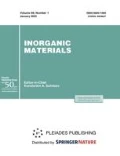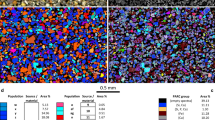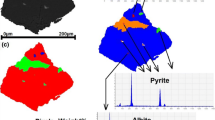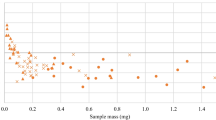Abstract
Physicochemical properties inherent in the solid component of welding aerosols (SCWA) are characterized. The features of SCWA sampling are considered. Methods are indicated which are most commonly used for the analysis of SCWA in Russian and foreign analytical practice. Destructive and nondestructive methods of SCWA analysis are compared, and their advantages and disadvantages are noted. By particular examples, it is shown that because of the complexity of phase and chemical composition of SCWA samples, rather frequently, one observes a loss of monitored elements in the course of the decomposition of exposed filters. Techniques for making synthetic calibration samples are considered for both classes of methods. In the case of using the X-ray fluorescence method, it is difficult to prepare calibration samples adequate to real SCWA samples collected on a filter. The comparative variant of neutron activation analysis involves synthetic mixtures for the calculation of the content of analytes containing one or two components. Metrological characteristics are presented for SCWA analysis techniques.
Similar content being viewed by others
References
Meo, S.A. and Al-Khlaiwi, T., Health hazards of welding fumes, J. Saudi. Med., 2003, vol. 24, no. 11, pp. 1176–1182.
Ahsan, S.A., Lackovic, M., Katner, A., and Palermo, C., Metal fume fever: a review of the literature and cases reported to the Louisiana poison control center, J. La. State Med. Soc., 2009, vol. 161, pp. 348–351.
Ellingsen, D.G., Dubeikovskaya, L., Dahl, K., Chashchin, M., Chashchin, V., Zibarevb, E., and Thomassena, Y., Air exposure assessment and biological monitoring of manganese and other major welding fume components in welders, J. Environ. Monit., 2006, vol. 8, pp. 1078–1086.
Palmer, K.T., McNeill-Love, R., Poole, J.R., Coggon, D., Frew, A.J., Linaker, C.H., and Shute, J.K., Inflammatory responses to the occupational inhalation of metal fume, J. Eur. Respir., 2006, vol. 27, no. 2, pp. 366–373.
MU 4945–88. Metodicheskie ukazaniya po opredeleniyu vrednykh veshchestv v svarochnom aerozole (tverdaya faza i gazy) (MU 4945–88. Method for Determination of Hazardous Substances in Welding Fume: Solid Phase and Gases), Moscow: Rarog, 1988.
Malyshev, B.D., Alekseev, E.K., and Blinov, A.N., Svarka i rezka v promyshlennom stroitel’stve (Welding and Cutting in Industrial Constructions), Moscow: Stroiizdat, 1989.
Voitkevich, V.G., Analysis of welding aerosols, Avtom. Svarka, 1982, no. 3, pp. 51–54.
MU 1924–78. Gigienicheskaya otsenka svarochnykh materialov i sposobov svarki, naplavki i rezki metallov: metodicheskie ukazaniya (MU 1924–78. Hygienic Evaluation of Welding Materials and Methods of Welding, Facing, and Cutting of Metals: Methodological Recommendations), Moscow: Minist. Zdravookhr. SSSR, 1980.
Kobayashi, M., Maki, S., Hashimoto, Y., and Suga, T., Some considerations about the formation mechanisms of welding fume, Weld. World, 1978, vol. 16, nos. 11–12, pp. 238–245.
Arc Welding Health Effects, Fume Formation Mechanisms, and Characterization Methods, Gonser, M. and Hogan, T., Eds., Rijeka: InTech, 2011, no. 16, pp. 299–320.
Kuznetsov, D.A., Ignatova, A.M., Fainburg, G.Z., and Ignatov, M.N., Analysis of the form of mineral elements of the solid part of welding fumes at the hand arc welding, Tekhnol. Tekhnosfernoi Bezop., 2013, vol. 52, no. 6, pp. 1–10.
Antonini, J.M., Afshari, A.A., Stone, S., Chen, B., Schwegler-Berry, D., Fletcher, W.G., Goldsmith, W.T., Vandestouwe, K.H., McKinney, W., Astranova, V., and Frazer, D.G., Design, construction, and characterization of a novel robotic welding fume generator and inhalation exposure system for laboratory animals, J. Occup. Environ. Hyg., 2006, vol. 3, pp. 194–203.
Berlinger, B., Benker, N., Weinbruch, S., Vov, B.L., Ebert, M., Koch, W., Ellingsen, D.G., and Thomassen, Y., Physicochemical characterization of different welding aerosols, Anal. Bioanal. Chem., 2011, no. 10, pp. 1773–1780.
Levchenko, O.G., The processes of formation of welding fumes, Avtom. Svarka, 1996, no. 4, pp. 17–22.
Buki, A.A. and Fel’dman, A.M., Prediction of aerosol composition at welding in protective gases, Svar. Proizvod., 1980, no. 2, pp. 6–8.
Lebedev, V.P., Bushlanova, S.I., and Turkovskii, I.I., Air protection in the industries, Ekol. Proizvod., 2006, no. 9, pp. 84–87.
Levchenko, O.G., Influence of shielding gas composition and welding mode on the total release of welding fumes, Avtom. Svarka, 1986, no. 1, pp. 73–74.
Matusiak, J. and Wycislik, J., Assessment of fume and chemical hazard in work environment during welding and braze welding of various construction materials by innovative methods, Biul. Inst. Spawal. (Gliwice), 2013, no. 5, pp. 5–20.
MUK 4.1.1354–03. Metodicheskie ukazaniya. Izmerenie massovykh kontsentratsii vanadiya, vismuta, zheleza, kobal’ta, margantsa, medi, nikelya, svintsa, khroma, tsinka rentgenofluorestsentnym metodom v vozdukhe rabochei zony (MUK 4.1.1354–03. Methodological Recommendations. Change of Mass Concentration of Vanadium, Bismuth, Iron, Cobalt, Manganese, Cooper, Nickel, Lead, Chromium, and Zinc by X-ray Fluorescence Analysis in the Air of Operation Zone), Moscow: Minist. Zdravookhr. Ross. Fed., 2003.
Metodika vypolneniya izmerenii massovoi kontsentratsii zheleza, kobal’ta, margantsa, medi, nikelya, svintsa, khroma, tsinka v ventilyatsionnykh vybrosakh rentgenofluorestsentnym metodom (M-049-V/99) (Measurement of Mass Concentration of Iron, Cobalt, Manganese, Cooper, Nickel, Lead, Chromium, and Zinc in Ventilation Emissions by X-ray Fluorescence Analysis (M- 049-V/99)), St. Petersburg: Spektron, 1999.
Golovatyuk, A.P., Levchenko, O.G., and Veblaya, T.S., Implementation of physical methods for analysis of the composition of the solid part of welding fumes, Svar. Proizvod., 1984, no. 3, pp. 37–38.
Zibarev, E.V., Modern methods of hygienic assessment of welding fume and prevention of its harmful effects on the employees, Extended Abstract of Cand. Sci. (Med) Dissertation, St. Petersburg, 2006.
Pushkin, S.G. and Mikhailov, V.A., Komparatornyi neitronno-aktivatsionnyi analiz: Izuchenie atmosfernykh aerozolei (Comparator Neutron Activation Analysis: The Study of Atmospheric Aerosols), Novosibirsk: Nauka, 1989.
North, M.R. and Haswell, S.J., Elemental analysis of welding fumes by x-ray fluorescence spectrometry, J. Anal. Atom. Spectrom., 1988, vol. 3, pp. 687–694.
Zimmer, A.T. and Biswas, P., Characterization of aerosols resulting from arc welding processes, J. Aerosol. Sci. 2001, vol. 32, pp. 993–1008.
Berlinger, B., Naray, M., Sajo, I., and Zaray, G., Critical evaluation of sequential leaching procedures for the determination of Ni and Mn species in welding fumes, Ann. Occup. Hyg., 2009, vol. 53, no. 4, pp. 333–340.
Pourtaghi, G., Kakooei, H., Salem, M., Pourtaghi, F., and Lahmi, M., Pulmonary effects of occupational exposure to welding fumes, Aust. J. Bas. Appl. Sci., 2009, vol. 3, no. 4, pp. 3291–3296.
Chauhan, S.K., Gupta, P.K., Shukla, A., and Gangopadhyay, S., Recent developments of certified reference materials for road transportation, Environ. Monit Assess., 2009, vol. 156, nos. 1–4, pp. 407–418.
Hariri, A., Yusof, M.Z.M., and Leman, A.M., Comparison of welding fumes exposure during standing and sitting welder’s position, World Acad. Sci., Eng. Technol., 2013, vol. 82, pp. 640–643.
Hurst, J.A., Volpato, J.A., and O’Donnell, G.E., The determination of elements in welding fume by X-ray spectrometry and UniQuant, X-Ray Spectrom., 2011, vol. 40, no. 2, pp. 61–68.
Hajar, S., Intasiri, A., Winder, C., and Khalil, C., In vitro cytotoxicity of mild steel and stainless steel welding fumes using human-derived cells, J. Environ. Health, 2013, vol. 4, no. 2, pp. 20–36.
Antonini, J.M., Stone, S., Roberts, J.R., Chen, B., Schwegler-Berry, D., Afshari, A.A., and Frazer, D.G., Effect of short-term stainless steel welding fume inhalation exposure on lung inflammation, injury, and defense responses in rats, Toxicol. Appl. Pharmacol., 2007, vol. 223, no. 3, pp. 234–245.
Hurst, J.A., Volpato, J.A., and O’Donnell, G.E., X-ray spectrometry analysis of welding fumes, Spectrosc. Eur., 2011, vol. 23, no. 5, pp. 24–27.
Laohaudomchok, W., Cavallari, J.M., Fang, S.C., Lin, X., Herrick, R.F., Christiani, D.C., and Weisskopf, M.G., Assessment of occupational exposure to manganese and other metals in welding fumes by portable X-ray fluorescence spectrometer, J. Occup. Environ. Hyg., 2010, vol. 7, no. 8, pp. 456–465.
Methods for the Determination of Hazardous Substances. Metals and Metalloids in Workplace air by X-Ray Fluorescence Spectrometry, Liverpool: Health Safety Executive, 1998.
Sowards, J.W., Lippold, J.C., Dickinson, D.W., and Ramirez, A.J., Characterization of welding fume from SWAW electrodes, Weld. Res. J., 2008, vol. 87, pp. 106–112.
Tandon, R.K., Ellis, J., Crisp, P.T., Baker, R.S., AND Electrodes, B.E., Chemical investigation of welding fumes from hard facing and HSLA-steel, Weld. J. 1986, no. 9, pp. 231–236.
Mansouri, N., Atbi, F., Moharamnezhad, N., Rahbaran, D.A., and Alahiari, M., Gravimetric and analytical evaluation of welding fume in an automobile part manufacturing factory, J. Res. Health Sci., 2008, vol. 8, no. 2, pp. 1–8.
Saito, H., Ojima, J., Takaya, M., Iwasaki, T., Hisanaga, N., Tanaka, S., and Arito, H., Laboratory measurement of hazardous fumes and gases at a point corresponding to breathing zone of welder during a CO2 arc welding, Ind. Health, 2000, no. 38, pp. 69–78.
NIOSH Manual of Analytical Methods (NMAM), Method 7200 “Welding and Brazing Fume,” Atlanta, GA: Natl. Inst. Occup. Safety Health, 1993, 4th ed.
Jenkins, N.T., Pierce, W.M.-G., and Eagar, T.W., Particle size distribution of gas metal and flux cored arc welding fumes, Weld. J., 2005, no. 10, pp. 156–163.
Jenkins, N.T. and Eagar, T.W., Chemical analysis of welding fume particles, Weld. J., 2005, no. 6, pp. 87–93.
Hinds, W.C., Aerosol Technology: Properties, Behavior, and Measurement of Airborne Particles, New York: Wiley, 1999.
Korzhova, E.N., Kuznetsova, O.V., Smagunova, A.N., and Stavitskaya, M.V., Determination of inorganic pollutants in atmospheric aerosols, J. Anal. Chem., 2011, vol. 66, no. 3, pp. 222–240.
Pokhodnya, I.K., Yavdoshchin, I.R., and Gubenya, I.P., Welding fumes: key factors, physical properties, and methods of analysis, Avtom. Svarka, 2011, no. 6, pp. 39–42.
Nastiti, A., Oginawati, K.A., and Santoso, M., Manganese exposure on welders in small-scale mild steel manual metal arc welding industry, J. Appl. Sci. Environ. Sanit., 2010, vol. 5, no. 3, pp. 227–238.
NIOSH Manual of Analytical Methods (NMAM), Method 7900 “Arsenic and Compounds (Exception AsH 3 and As 2 O 3 ),” Atlanta, GA: Natl. Inst. Occup. Safety Health, 1994, 4th ed.
NIOSH Manual of Analytical Methods (NMAM), Method 7901 “Arsenic (As),” Atlanta, GA: Natl. Inst. Occup. Safety Health, 1994, 4th ed.
NIOSH Manual of Analytical Methods (NMAM), Method 7048 “Cadmium and Compounds,” Atlanta, GA: Natl. Inst. Occup. Safety Health, 1994,4th ed.
NIOSH Manual of Analytical Methods (NMAM), Method 7024 “Chromium and Compounds,” Atlanta, GA: Natl. Inst. Occup. Safety Health, 1994, 4th ed.
NIOSH Manual of Analytical Methods (NMAM), Method 7082 “Lead by Flame AAS,” Atlanta, GA: Natl. Inst. Occup. Safety Health, 1994, 4th ed.
NIOSH Manual of Analytical Methods (NMAM), Method 7105 “Lead by GFAAS,” Atlanta, GA: Natl. Inst. Occup. Safety Health, 1994, 4th ed.
Determination of Total Chromium and Hexavalent Chromium Emissions from Stationary Sources (Method 425), Sacramento, CA: Calif. Environ. Prot. Agency, 1997.
Determination of Inorganic Lead Emissions from Stationary Sources Adopted (Method 12), Sacramento, CA: Calif. Air Resour. Board, 1999.
Butler, O. Rimmer, D., and Davies, P., Reference Material HSL MSWF-1. Elements in Mild Steel Welding Fume, Buxton: Health Safety Lab., 2013.
Hariri, A., Yusof, M.Z.M., and Leman, A.M., Sampling method for welding fumes and toxic gases in malaysian small and medium enterprises (SMEs), Energy Environ. Res, 2012, vol. 2, no. 2, pp. 13–20.
Berlinger, B., Comparison and evaluation of sampling and analytical methods in the determination of toxic metals in workplace welding fumes, MSc Thesis, Budapest, 2009.
Botta, C., Iarmarcovai, G., Chaspoul, F., Sari-Minodier, I., Pompili, J., Orsiere, T., Berge-Lefranc, J.-L., Botta, A., Gallice, P., and Meo, M.D., Assessment of occupational exposure to welding fumes by inductively coupled plasma-mass spectroscopy and by the alkaline comet assay, Environ. Mol. Mutagen, 2006, no. 47, pp. 284–295.
Berg, T., Royset, O., and Steinnes, E., Blank values of trace elements in aerosol filters determined by ICP-MS, Atmos. Environ., 1993, vol. 27, pp. 2435–2439.
Ascenco, C.G., Gomes, J.F.P., Cosme, N.M., and Miranda, R.M., Analysis of welding fumes: a short note on the comparison between two sampling techniques, Toxicol. Environ. Chem, 2005, vol. 87, no. 3, pp. 345–349.
NIOSH Manual of Analytical Methods (NMAM), Method 7300 “Elements (ICP),” Atlanta, GA: Natl. Inst. Occup. Safety Health, 2003.
Chang, D.P.Y., Krone, R.B., Heung, W., Yun, M., and Green, P.G., Improving Welding Toxic Metal Emission Estimates in California, Sacramento, CA: Calif. Air Resour. Board, 2004, p. 33.
NIOSH Manual of Analytical Methods (NMAM), Method 7600 “Chromium, Hexavalent,” Atlanta, GA: Natl. Inst. Occup. Safety Health, 1994.
Ennan, A.A., Dzerzhko, E.K., and Sakhno, S.P., Determination of fluorine compounds in the air of working zone of welding industries, Zavod. Lab., 1997, vol. 63, no. 10, pp. 13–16.
Dyagileva, E.V., Otmakhova, Z.I., and Kuleshov, V.I., Implementation of atomic-emission analysis for the control of air cleanliness, Zh. Anal. Khim., 1990, vol. 45, no. 1, pp. 154–159.
Bok, R., Metody razlozheniya v analiticheskoi khimii (Methods of Decomposition in Analytical Chemistry), Moscow: Khimiya, 1984.
Metal and Metalloid Particulates in Workplace Atmospheres (ICP Analysis). Method No. ID-125G, Salt Lake City, UT: Occup. Safety Health Admin., 2002.
Kundiev, Yu.I., Mazur, A.A., and Gorban’, L.N., Gigienicheskie I ekonomicheskie aspekty problemy bor’by so svarochnymi aerozolyami Hygienic and economic aspects of the fight against welding fumes, Svar. Proizvod., 1987, no. 3, pp. 1–3.
Doroshenko, N.V., Specific analysis of dust samples, released during gas cutting of scrap metal, Zavod. Lab., 1998, vol. 64, no. 3, pp. 13–15.
Olah, L. and Pivoluska, J., Determination of chromium (VI) in welding fumes by radionuclide X-ray fluorescent analysis, J. Radioanal. Nucl. Chem, 1985, vol. 96, no. 6, pp. 575–584.
Marcy, D. and Drake, P.L., Development of a field method for measuring manganese in welding fume, J. Environ. Monit, 2007, vol. 9, no. 11, pp. 1194–1204.
GOST (State Standard) 12.1.005–88: The System of Standards of Labor Safety. General Sanitary-Hygienic Requirements to the Workplace Zone, Moscow: Standartinform, 2006.
Harper, M., Pacolay, B., Hintz, P., Bartley, D.L., Slaven, J.E., and Andrew, M.E., Portable XRF analysis of occupational air filter samples from different workplaces using different samplers: final results, summary, and conclusions, J. Environ. Monitor, 2007, vol. 9, no. 11, pp. 1263–1270.
Drobyshev, A.N. and Emelina, O.N., Analysis of atmospheric aerosols by atomic emission spectrometry with electrical discharge sampling, J. Anal. Chem., 2001, vol. 56, no. 6, pp. 577–580.
Isaxon, C., Pagels, J., Gudmundsson, A., Asbach, C., John, A.C., Kuhlbusch, T.A.J., Karlsson, J.E., Kammer, R., Tinnerberg, H., Nielsen, J., and Bohgard, M., Characteristics of welding fume aerosol investigated in three Swedish workshops, J. Phys. Conf, 2009, vol. 151, no. 1, pp. 1–5.
NIOSH Manual of Analytical Methods (NMAM), Method 7702 “Lead by Field Portable XRF,” Atlanta, GA: Natl. Inst. Occup. Safety Health, 1998.
Swamy, K., Kaliaperumal, R., and Swaminathan, G.S., Wavelength-dispersive X-ray fluorescence spectrometric technique for determining elements in weld fumes, X-Ray Spectrom., 1994, vol. 23, pp. 71–74.
Voitkevich, V.G., X-ray fluorescence analysis of the solid component of welding fumes, in Metody rentgenospektral’nogo analiza (Methods of X-Ray Analysis), Novosibirsk: Nauka, 1985, pp. 82–85.
Morley, J.C., Clark, C.S., Deddens, J.A., Ashley, K., and Roda, S., Evaluation of a portable X-ray fluorescence instrument for the determination of lead in workplace air samples, Appl. Occup. Environ. Hyg., 1999, no. 14, pp. 306–316.
Nastiti, A., Pramudyastuti, D.Y., Oginawati, K., and Santoso, M., Determination of informal sector as urban pollution source: fume characterization of smallscale manual metal arc welding using factor analysis in Bandung city, Atom. Indones., 2012, vol. 38, no. 1, pp. 35–42.
Zolotov, Yu.A., Ocherki analiticheskoi khimii (Essays in Analytical Chemistry), Moscow: Khimiya, 1977.
Kolotov, V.P., Theoretical and experimental approaches to the problems of activation analysis, gamma spectrometry, and the creation of low-activated materials, Extended Abstract of Doctoral (Chem.) Dissertation, Moscow, 2007.
Elements in Mild Steel Welding Fume. Certificate of Analysis HSL MSWF-1, Buxton: Health Safety Lab., 2013.
Karmanov, V.I. and Sidlin, Z.A., Control of composition of welding fumes during welding with coated electrodes for special purposes, Svar. Proizvod., 2001, no. 10, pp. 35–37.
Wajen, V., Heavy metals in genuine air particulate matter on filter: certification of a novel reference material, 9th Int. Symp. on Biological and Environmental Reference Materials, June 15–19, 2003, Berlin, Germany, Abstracts of Papers, Berlin, 2003.
Anglov, J.T.B., Holst, E., Dyg, S., and Christensen, M., Iron, manganese, copper and titanium in welding fume dust on filters for internal and external quality assurance, Fresenius J. Anal. Chem., 1993, vol. 345, nos. 2–4, pp. 335–339.
Sreekanthan, P., Study of chromium welding fume, PhD Thesis, Cambridge, MA: Mass. Inst. Technol., 1997.
Shestakov, V.A., Arkhipov, N.A., Makarov, D.F., and Smagunova, A.N., Preparation of the reference-frames for X-ray analysis of powder materials, Zavod. Lab., 1975, vol. 41, no. 8, pp. 948–950.
Author information
Authors and Affiliations
Corresponding author
Additional information
Original Russian Text © E.N. Korzhova, T.V. Stepanova, S. Lodousamba, A.N. Smagunova, 2015, published in Zavodskaya Laboratoriya, Diagnostika Materialov, 2015, Vol. 81, No. 7, pp. 6–18.
Rights and permissions
About this article
Cite this article
Korzhova, E.N., Stepanova, T.V., Lodousamba, S. et al. Monitoring of welding aerosol compositions (a review). Inorg Mater 52, 1420–1430 (2016). https://doi.org/10.1134/S0020168516140089
Received:
Published:
Issue Date:
DOI: https://doi.org/10.1134/S0020168516140089




